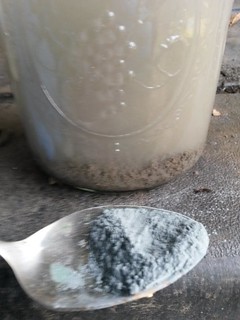upcyclist
Well-known member
A quick description of the problem: I'm in charge of the shop at a local lapidary guild in the Midatlantic coast area (US). Our current shop has a frightening amount of old plating solutions laying around--some we inherited, the balance due to the guild just buying more supplies instead of figuring out if the old stuff is still any good or not. We haven't done much plating in quite a few years, so that puts the age of these materials at anywhere from 10 to 50 years old.
We're talking about roughly 5 dozen bottles in the pint/quart/gallon range. Some of it is labeled, and most of the labeled gold solutions are cyanide-based. I'm guessing from the color that a lot of the unlabeled bottles are simply old nickel solutions, but I'm unsure of the chemistry (also cyanide?).
What are my options?
Scaring the bejesus out of my local county dump on hazmat day doesn't sound like the best plan, and they're more likely to treat the cyanide problem and not worry about the gold, a horrible loss in my opinion. That's if they'll even accept the waste, since most are unlabeled and the rest are labeled "cyanide".
The more likely options are try to get the materials to a recovery specialist or take the DIY route.
The Board might prefer the former (recovery specialist), but I'd still need to figure out what state to get those materials in--I'm guessing the USPS is a big fat NO, and even a local refiner probably doesn't want to deal in cyanide plating solutions. Would ion exchange resin be something to try in this vein?
The latter DIY option would be far more interesting: test what I can and determine content (stannous chloride, etc.), and take my time recovering the gold & other precious metals, mitigate the nickel, etc. I've a fair mind for chemistry, but honestly haven't done a whole lot since AP Chem in high school. So I'd need to do a bunch of reading, get the right equipment, figure out safety, etc. I promise not to throw acid in the cyanide, I swear
In a few hours of reading (and I'm glad I found this forum!), including a quick scan of Hoke, I've figured out that for the gold/cyanide solutions at least, I could use zinc powder to precipitate out the gold, and possibly even stabilize the remaining solution into ferrocyanide or even Prussian blue. Am I on the right path here?
We're talking about roughly 5 dozen bottles in the pint/quart/gallon range. Some of it is labeled, and most of the labeled gold solutions are cyanide-based. I'm guessing from the color that a lot of the unlabeled bottles are simply old nickel solutions, but I'm unsure of the chemistry (also cyanide?).
What are my options?
Scaring the bejesus out of my local county dump on hazmat day doesn't sound like the best plan, and they're more likely to treat the cyanide problem and not worry about the gold, a horrible loss in my opinion. That's if they'll even accept the waste, since most are unlabeled and the rest are labeled "cyanide".
The more likely options are try to get the materials to a recovery specialist or take the DIY route.
The Board might prefer the former (recovery specialist), but I'd still need to figure out what state to get those materials in--I'm guessing the USPS is a big fat NO, and even a local refiner probably doesn't want to deal in cyanide plating solutions. Would ion exchange resin be something to try in this vein?
The latter DIY option would be far more interesting: test what I can and determine content (stannous chloride, etc.), and take my time recovering the gold & other precious metals, mitigate the nickel, etc. I've a fair mind for chemistry, but honestly haven't done a whole lot since AP Chem in high school. So I'd need to do a bunch of reading, get the right equipment, figure out safety, etc. I promise not to throw acid in the cyanide, I swear
In a few hours of reading (and I'm glad I found this forum!), including a quick scan of Hoke, I've figured out that for the gold/cyanide solutions at least, I could use zinc powder to precipitate out the gold, and possibly even stabilize the remaining solution into ferrocyanide or even Prussian blue. Am I on the right path here?















































